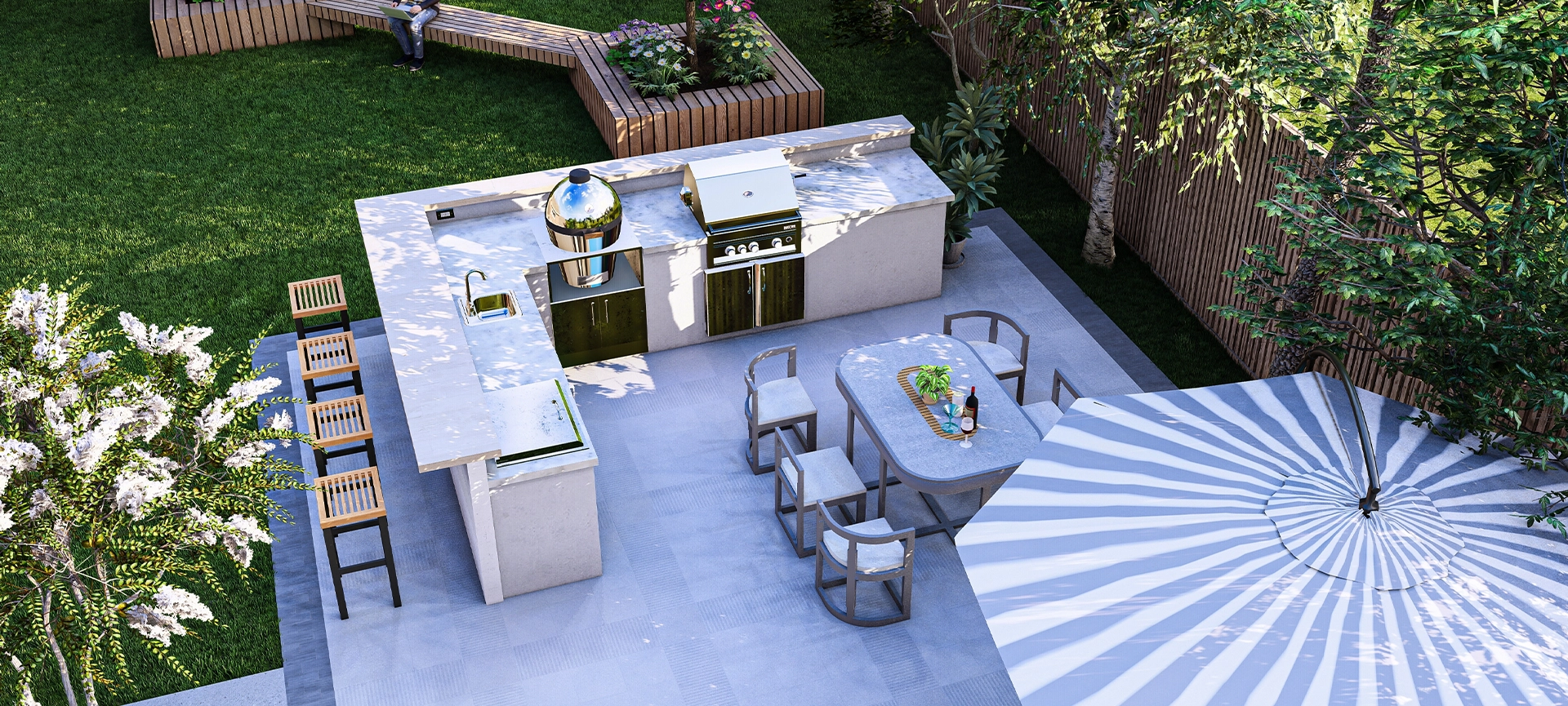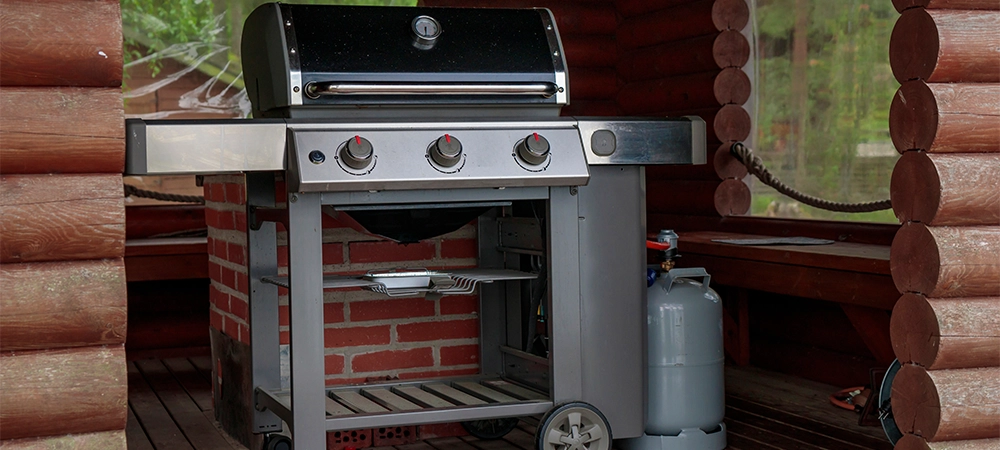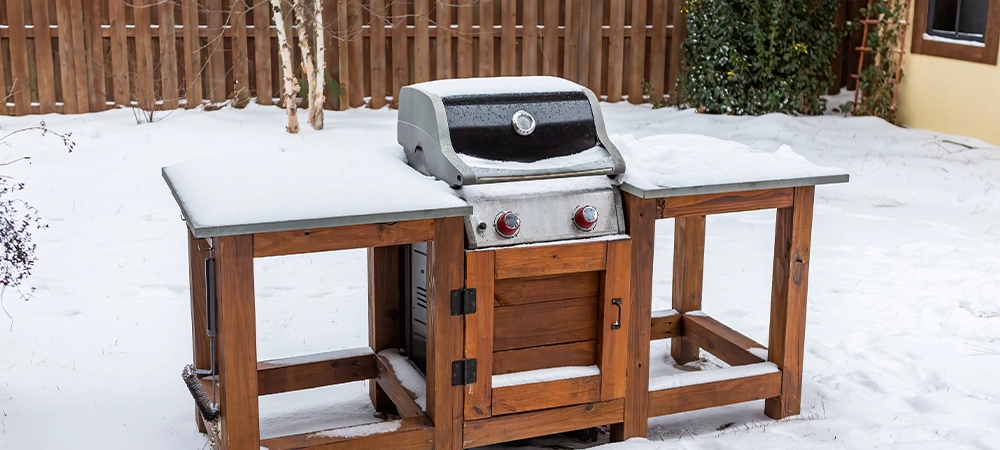
Outdoor kitchens are a great way to extend living space, but once the temperature drops, they need special care. Proper winterization protects your investment from freezing, cracking, and corrosion so you can enjoy a seamless return to cooking outdoors in spring.
Whether your kitchen includes a built-in grill, sink, stone counters, or a pizza oven, winter preparation ensures every element stays safe and functional through the cold months. Here’s how to do it right.
Related Article: Top 3 Outdoor Upgrades Before Winter Hits
Shut Off and Drain All Water Lines
Water expands when it freezes. If any moisture remains in your pipes or fixtures, it can lead to burst lines and damaged plumbing. Start by turning off the water supply to the outdoor kitchen from inside your home.
Next, open the outdoor faucet or sink tap to drain all remaining water. Use compressed air to clear the lines completely if possible. Don’t forget the dishwasher, fridge water line, or ice maker; they often hold hidden water pockets that can freeze and cause cracks.
For extra protection, pour non-toxic antifreeze into traps or drains to prevent freezing in low points.
Disconnect and Store Appliances
Grills, refrigerators, and side burners should be disconnected from gas and power sources before the first frost. Clean all equipment thoroughly. Food residue attracts pests, and moisture leads to corrosion.
Remove portable appliances and store them indoors. For built-in units, disconnect propane or natural gas lines (if safe to do so) and close shutoff valves tightly. Stainless steel surfaces should be polished with mineral oil or stainless steel cleaner to prevent rust.
If you have a wine fridge or beverage cooler, prop the door open slightly once cleaned. This prevents mould growth from trapped humidity.
Clean and Protect Your Grill
Even if your grill is built into stonework, it needs proper cleaning before winter. Scrub grates with a grill brush, remove grease buildup, and empty the drip pan. Burn off any remaining residue with a brief high-heat cycle.
Once cooled, coat metal parts lightly with cooking oil or a corrosion inhibitor. Cover the grill with a weatherproof cover designed for cold climates. Avoid thin vinyl covers that can crack—look for UV- and moisture-resistant materials.
For charcoal grills, empty ashes completely. Ash retains moisture, which can rust the base during storage.
Safeguard Countertops and Cabinets
Natural stone, concrete, and tile counters are durable but still porous. Apply a fresh coat of sealant before winter to prevent water absorption and frost damage.
Wipe down all surfaces, including cabinet interiors. Remove any items that can freeze or attract rodents—such as condiments, paper goods, and cleaning products.
If your cabinets are made of wood or composite material, clean and dry them thoroughly before covering. You can also add weatherstripping around doors to block moisture and insects.
Disconnect Gas Lines and Power Sources
For built-in grills, fire pits, or heaters, it’s essential to turn off gas supply lines at the source. Check for leaks before sealing connections with protective caps.
Unplug all electrical appliances, including refrigerators and outdoor lighting fixtures. If outlets are exposed, use weatherproof covers to keep out moisture.
Gas tanks should be stored in a ventilated shed or garage (never indoors) and kept upright on a non-freezing surface such as concrete or pavers.
Related Article: How to Winterize a Swimming Pool

Protect Plumbing Fixtures and Sinks
Outdoor sinks and bar faucets are highly prone to freeze damage. Once drained, remove the faucet if possible and store it inside. If not, cover the fixture with an insulated faucet protector.
Check that drain traps under sinks are completely dry, or use RV antifreeze for extra protection. Insulate exposed pipes with foam sleeves or wrap heating tape if you live in a region with severe frost.
Cover Appliances and Surfaces Properly
Covers are the first line of defence against snow, ice, and UV damage. Choose breathable materials that allow air circulation while keeping moisture out.
Avoid plastic tarps; they trap condensation and encourage mould growth. Instead, use purpose-made outdoor appliance covers for grills, sinks, and fridges.
If your kitchen includes a pergola or roof, inspect it for leaks or loose panels before winter. Proper drainage prevents ice buildup that could strain the structure.
Seal Gaps and Check for Drainage
Water pooling around your outdoor kitchen can seep into materials and freeze. Before winter, inspect the area for low spots or clogged drains.
Use a leaf blower or broom to clear debris from paver joints, gutters, and nearby drains. If your kitchen sits on a deck, make sure there’s no water trapped underneath cabinets or flooring.
Seal any visible cracks in grout or stone joints to stop water penetration. Small repairs now prevent major damage later.
Related Article: Preparing Your Deck for Winter: Checklist
Care for Outdoor Furniture and Accessories
Even weather-resistant furniture benefits from winter protection. Wash and dry cushions before storing them in a dry area.
Wipe down metal frames and apply car wax to resist rust. For wooden furniture, add a coat of sealant. Cover or stack chairs and tables away from direct exposure to snow and wind.
Remove accessories such as cutting boards, utensils, and décor. Storing them indoors keeps everything fresh and ready for spring.
Maintain Landscaping Around the Kitchen
Trim nearby shrubs and trees so branches don’t scrape or drop heavy snow onto your counters or roof structure.
Clean leaves and soil from garden beds adjacent to the kitchen; debris holds moisture and can promote rot.
If your outdoor kitchen includes stone paths or interlocking retaining walls, check for loose stones and repair them before the freeze-thaw cycle begins.
Related Article: How to Winterize a Swimming Pool
Bonus Tip: Schedule a Professional Inspection
A seasonal inspection from a landscape and construction expert ensures every component is properly secured for winter. Green Side Up Contracting’s team checks gas, water, and electrical connections, inspects for structural wear, and applies protective sealants where needed.
This proactive step saves time and prevents costly spring repairs. It also keeps your outdoor kitchen compliant with safety standards and ready for early spring gatherings.
Why Winterizing Matters
Winterizing isn’t just about avoiding damage; it extends the lifespan of your outdoor investment. Freezing temperatures, snow, and moisture can weaken materials, fade finishes, and cause plumbing failures.
Proper preparation ensures your outdoor kitchen remains a functional, beautiful space for years to come. Plus, when spring arrives, you’ll only need a quick clean-up instead of costly replacements.

Keep Your Outdoor Space Protected Year-Round
Preparing your outdoor kitchen for winter is a small effort that delivers big returns. From sealing stonework to insulating water lines, every step helps preserve the craftsmanship and comfort of your outdoor living area.
If you’d rather have professionals handle it, Green Side Up Contracting provides full seasonal maintenance, winterization, and inspection services across the Greater Toronto Area and York Region. Our expertise ensures your kitchen, deck, and landscape stay in top shape through every season.
Call us to schedule your winter preparation today.
Frequently Asked Questions
1. When should I start winterizing my outdoor kitchen in Ontario?
Begin before the first hard frost, typically late October to early November in the Greater Toronto Area.
2. Can I use my outdoor grill in winter?
Yes, but ensure gas lines and burners are clear of snow and moisture. Use a heavy-duty cover when not in use.
3. Should I seal my outdoor countertops every year?
Annual sealing protects stone or concrete from moisture absorption and freeze-thaw cracking.
4. How do I protect a built-in refrigerator during winter?
Unplug it, clean thoroughly, and cover it with a breathable outdoor appliance cover.
5. How do I keep outdoor cabinets from swelling or warping in winter?
Empty all contents, wipe interiors dry, and use weatherstripping or moisture absorbers to control humidity inside the cabinets.
6. Can I protect my outdoor kitchen plumbing without using antifreeze?
Fully drain lines, disconnect fixtures, and use compressed air to remove any trapped water instead of relying on antifreeze.
7. What should I do if my outdoor kitchen doesn’t have a roof?
Invest in fitted waterproof covers for each appliance and add a temporary canopy or pergola cover to shield the area from snow buildup.
8. Do stone countertops need special care after heavy snowfall?
Brush off snow gently to prevent moisture absorption, then reapply a sealer once temperatures rise above freezing to maintain protection.
9 . What if my outdoor kitchen doesn’t have a shutoff valve?
Have a plumber install one before winter. It’s the safest way to prevent burst lines.
